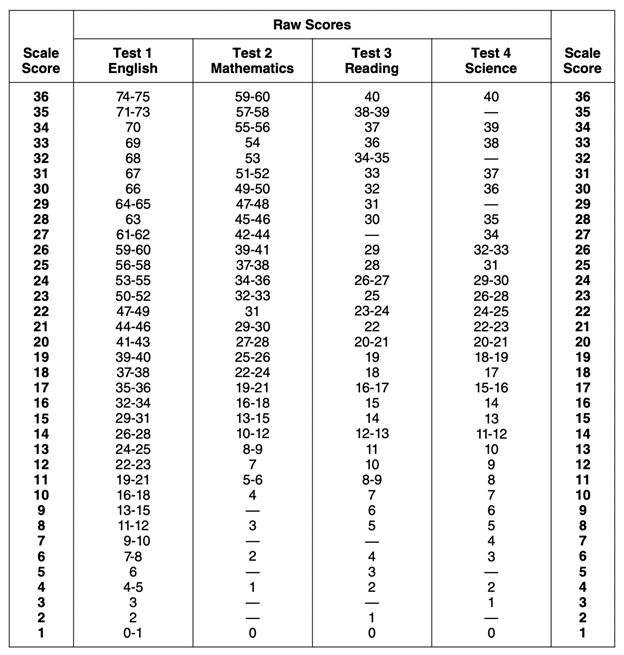How to Get a Perfect 36 Score on the ACT
A perfect score of 36 on the ACT may seem elusive – in fact, less than one percent of ACT test takers receive a score of 36. But, don’t let this statistic scare you! With hard work and persistence, you can be one of those perfect scorers. Keep reading to learn more about the scoring process and what you can do to get a 36 on the ACT. The ACT is composed of four sections: English, mathematics, reading, and science. For each section, your raw multiple choice score is scaled to a score ranging from 1 to 36. Then, your four scores are averaged to comprise a composite score (which is also out of 36). Your average score is rounded to the nearest whole number. So, for example, if your average is 32.25, you’ll receive a 32. Or, if your average is 34.75, your score will become 35. Remember, there is no penalty for guessing, so your raw score is solely dependent on the number of questions you answer correctly. This means that it is in your best interest to not leave any questions blank. Because the composite score is rounded either up or down, you won’t have to answer every single question correctly to get a score of 36. Here are the different types of section breakdowns which will result in a composite score of 36 on the ACT: For example, consider the following breakdown: English: 36 Math: 36 Reading: 34 Science: 36 Average: 35.5 Composite score: 36 For example, consider the following breakdown: English: 36 Math: 35 Reading: 36 Science: 35 Average: 35.5 Composite score: 36 For example, consider the following breakdown: English: 36 Math: 35 Reading: 36 Science: 36 Average: 35.75 Composite score: 36 For example, consider the following breakdown: English: 36 Math: 36 Reading: 36 Science: 36 Average: 36 Composite score: 36 So, as you can see, you’ll still need to do significantly well on each section to get a perfect score overall. That said, you don’t need a perfect score on every section to get a perfect composite score. Since, in most cases, you’ll need either a 35 or 36 on each section of the ACT, let’s discuss what that means in terms of how many questions you’re able to miss. To better understand this, let’s look at the raw score conversion chart for an official practice ACT test: From this chart, we can see that you’ll likely need either a perfect or near perfect raw score to receive a 36 or 35 on each section. Based on the ACT practice tests, most sections require you to miss 0 questions to receive a score of 36. However, in the Math section, you might be able to miss 1 question and still receive a 36. Receiving a score of 35 most often entails missing 1–3 questions in each section. So, as you’re studying for the ACT, though your goal should be to answer every question correctly, keep in mind that you’re allowed to miss a small number of questions and still receive a composite score of 36. Also, remember that the conversion scales vary from test to test, so these cutoffs are not set in stone. Now that we’ve covered the scoring process, let’s delve into some tips and tricks to receive the section scores you’ll need for a composite score of 36. Though this may seem obvious, it’s important to prioritize the sections which you score lower in. But, this doesn’t mean that you should completely ignore the subjects which you excel in – even if you score 36 on your very first practice Math ACT Test, you should still refresh your math skills from time to time so you don’t enter the ACT with rusty math knowledge. Before you start planning your studying, take a full-length, timed ACT test. This will give you some insight into which sections you’re weaker in. Then, you can plan out your studying by prioritizing weaker subjects. For example, say you receive the following breakdown on a practice test: English: 33 Math: 36 Reading: 32 Science: 34 In this case, you might set up the following study schedule: Mondays: English practice Tuesdays: Reading practice Wednesdays: Math and Science practice Thursdays: Review missed questions/difficult concepts Fridays: Full-length practice test This schedule is helpful, because though you’re spending more time on English and Reading than Math and Science, you’re still not completely neglecting the latter two subjects. However you choose to plan out your studying, make sure you know which sections to dedicate more time to. [amp-cta id="9459"] Since test-takers often fall victim to the clock on the ACT, make sure that you’ve got your timing down. Though it’s important to work on pacing while you study (i.e. time yourself when you complete practice questions), don’t risk missing questions by speeding through the test. It’s important to learn to balance speed and accuracy: though you don’t want to waste time by spending too much time on one question, you also don’t want to go too fast and make careless mistakes. Finding that perfect balance requires time and practice. When you take timed practice tests, pay attention to whether you run out of time or whether you finish early – if you find yourself running out of time, work on skipping difficult questions and coming back to them; if you find yourself finishing early, try learning how to go back and catch mistakes. You should make sure to start studying early enough so that you can determine the best studying and test-taking strategies for you. Everyone learns differently, so what might work for others might not work well for you. Here are a few studying and test-taking strategies that you should try out: The pomodoro method This method is utilized by many and involves studying in intervals. For instance, you could study for 25 minutes then take a 5 minute break. This spaces out your studying and ensures that you’re giving yourself short mental breaks, which is good for retention. Skipping difficult questions A great time-saver for the ACT is to go through and complete all the easy questions first. Since all questions are weighted equally, if 5 easy questions takes the same amount of time as 1 difficult question, it’s in your best interest to answer the easier questions. However, this doesn’t mean you shouldn’t come back to the difficult questions. Once you’ve gone through all the easy questions, make sure to answer the questions you’ve skipped. Since there are no penalties for guessing, don’t leave any questions blank. If you are able to eliminate some wrong answers for these skipped questions, make an educated guess. If you don’t have time to eliminate any answers, guess the same answer choice consistently (like answer choice “C”). Picking the same answer will give you a 20% chance overall of getting these questions right. This is why practicing your timing is crucial, since you want to make sure you have enough time left to tackle the difficult questions after you’ve completed the easier ones – if you guess on a lot of questions, getting a 36 will be much harder. Like any other standardized test, the key to the ACT is practice, practice, practice! Take as many tests as you can to determine your strengths and weaknesses. But, the important caveat is that you should time yourself as much as possible – simulate test day as often as you can to get yourself in the proper headspace. Then, when test day comes, you’ll be more familiar and at ease in an inevitably stressful environment. Practice tests are helpful for two main reasons: learning the material and identifying weak spots. Doing numerous practice questions will help you retain the knowledge better and have a stronger grasp on the various concepts tested on the SAT. Also, if you consistently miss problems regarding specific topics or content areas, you’ll know where to focus your studying. Though it is important to get as much studying in as possible, getting rest is equally essential. You want to be especially well-rested in the week leading up to the test. You might be tempted to cram or study especially hard the night before the test, but instead try to take the night before your test off. Look over old practice tests or notes briefly, but try not to do too much studying the day before. But, beware the other extreme: if you regularly go to bed at 11 while studying for the ACT, don’t sleep too early the night before. Try to stay consistent with your sleeping schedule in the weeks leading up to the test so that your body is well-adjusted by the time test day approaches. Your ACT score is used (along with your GPA) to calculate a metric called the Academic Index (AI). Your AI helps determine the academic strength of your application. Though this has changed temporarily in light of the COVID-19 pandemic, highly selective colleges sometimes even reject applicants with too-low AIs. To see how your score affects your chances of admission, check out CollegeVine’s free Admissions Calculator! This will not only calculate your chances at your schools of choice, but will also offer tips on how best to improve the rest of your profile. Though your journey to a perfect 36 on the ACT won’t be easy, it doesn’t mean that it’s an impossible feat. If you have determination and a growth mindset, a score of 36 is definitely feasible! Take a look at some of CollegeVine’s other guides to the ACT: What’s Covered:
How is the ACT scored?
What does it take to get a perfect ACT score?
1. Scoring 34 on one section and 36 on the other three sections.
2. Scoring 35 on two sections and 36 on the other two sections.
3. Scoring 35 on one section and 36 on the other three sections.
4. Scoring 36 on all four sections.
How many questions can you miss?

Steps to Getting a Perfect ACT score
1. Prioritize weaker subjects

2. Work on pacing
3. Experiment with different strategies
4. Take practice tests
5. Get as much rest as possible
How Does Your ACT Score Impact Your College Chances?
The Takeaway



